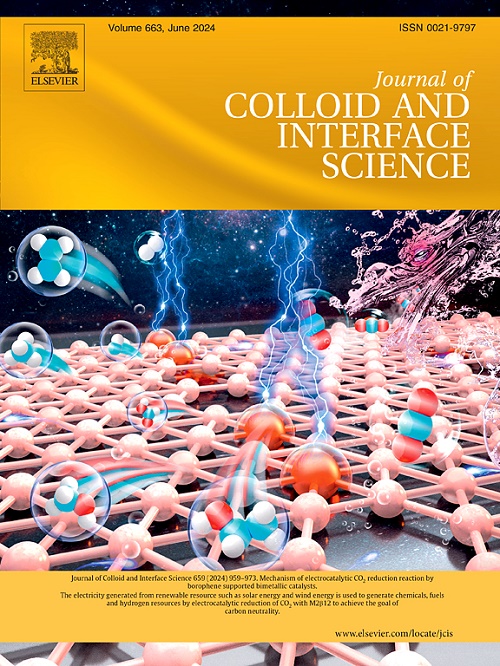通过将金刚石颗粒与石墨桥接,提高液态金属的导热性。
IF 9.4
1区 化学
Q1 CHEMISTRY, PHYSICAL
引用次数: 0
摘要
液态金属(LM)复合材料被认为在电子热管理方面具有潜在而广泛的应用。提高液态金属的热导率是一个关键问题。在此,我们开发了一种新型的共晶镓铟 (EGaIn) / 金刚石/石墨液态金属复合材料。该复合材料的最高热导率为 133 ± 3 W m-1 K-1,比基体的热导率高出 411%。键合机理表明,石墨和 EGaIn 的界面吸附能(ΔE)可通过石墨的官能团(-OH 降低 108%,-CO 降低 125%)和 EGaIn 的氧化物(-64%)有效降低。此外,金刚石和 EGaIn 的 ΔE 可以通过 EGaIn 的氧化(-83%)和金刚石的 H 端(-187%)而显著降低。热传导机制表明,在 EGaIn/40 Vol% 金刚石/石墨复合材料中,3 Vol% 的石墨含量可在金刚石颗粒之间形成极佳的热传导桥。然而,当石墨添加过多时,复合材料的热导率会明显降低,原因是石墨容易包覆金刚石颗粒。EGaIn 与金刚石和石墨混合后,其熔点没有明显变化。作为一种热界面材料,EGaIn/金刚石/石墨复合材料在 LED 灯和 CPU 散热方面也表现出优异的热管理性能,尤其是在大功率电子设备中。这项研究通过将球形颗粒与片状材料桥接,展示了提高基于 LM 的复合材料导热性能的潜力。本文章由计算机程序翻译,如有差异,请以英文原文为准。

Boosted the thermal conductivity of liquid metal via bridging diamond particles with graphite
The liquid metal (LM) composite is regarded as having potential and wide-ranging applications in electronic thermal management. Enhancing the thermal conductivity of LM is a crucial matter. Herein, a novel LM composite of eutectic gallium-indium (EGaIn)/diamond/graphite was developed. A highest thermal conductivity of 133 ± 3 W m−1 K−1 was achieved, 411 % higher than that of the matrix. The bonding mechanism reveals that the interfacial adsorption energy () of graphite and EGaIn can be effectively decreased by the functional groups of graphite (by −108 % for –OH and −125 % for −C![]() O) and the oxide of EGaIn (by −64 %). Furthermore, the of diamond and EGaIn can be significantly reduced through the oxidation of EGaIn (by −83 %) and the H-terminal of diamond (by −187 %). The thermal conductance mechanism suggests that a 3 vol% graphite content in the EGaIn/40 vol% diamond/graphite composite can form an excellent thermal conductance bridge among diamond particles. However, the thermal conductivity of the composite significantly decreased when too much graphite was added due to the tendency of the graphite to coat the diamond particles. There was no significant change in the melting point of EGaIn after being mixed with diamond and graphite. The EGaIn/diamond/graphite composite also demonstrated excellent thermal management performance in LED lamps and CPU heat dissipation as a thermal interface material, particularly in high-power electronic devices. This work presents the potential to enhance the thermal conductivity of LM-based composite by bridging spheroidal particles with a flaky material.
O) and the oxide of EGaIn (by −64 %). Furthermore, the of diamond and EGaIn can be significantly reduced through the oxidation of EGaIn (by −83 %) and the H-terminal of diamond (by −187 %). The thermal conductance mechanism suggests that a 3 vol% graphite content in the EGaIn/40 vol% diamond/graphite composite can form an excellent thermal conductance bridge among diamond particles. However, the thermal conductivity of the composite significantly decreased when too much graphite was added due to the tendency of the graphite to coat the diamond particles. There was no significant change in the melting point of EGaIn after being mixed with diamond and graphite. The EGaIn/diamond/graphite composite also demonstrated excellent thermal management performance in LED lamps and CPU heat dissipation as a thermal interface material, particularly in high-power electronic devices. This work presents the potential to enhance the thermal conductivity of LM-based composite by bridging spheroidal particles with a flaky material.
求助全文
通过发布文献求助,成功后即可免费获取论文全文。
去求助
来源期刊
CiteScore
16.10
自引率
7.10%
发文量
2568
审稿时长
2 months
期刊介绍:
The Journal of Colloid and Interface Science publishes original research findings on the fundamental principles of colloid and interface science, as well as innovative applications in various fields. The criteria for publication include impact, quality, novelty, and originality.
Emphasis:
The journal emphasizes fundamental scientific innovation within the following categories:
A.Colloidal Materials and Nanomaterials
B.Soft Colloidal and Self-Assembly Systems
C.Adsorption, Catalysis, and Electrochemistry
D.Interfacial Processes, Capillarity, and Wetting
E.Biomaterials and Nanomedicine
F.Energy Conversion and Storage, and Environmental Technologies

 求助内容:
求助内容: 应助结果提醒方式:
应助结果提醒方式:


